This post contains affiliate links
Ever wonder how to make hard kombucha (i.e. kombucha with more alcohol in it)? We’re breaking down the basics to alcoholic kombucha. It’s easier than you would think!
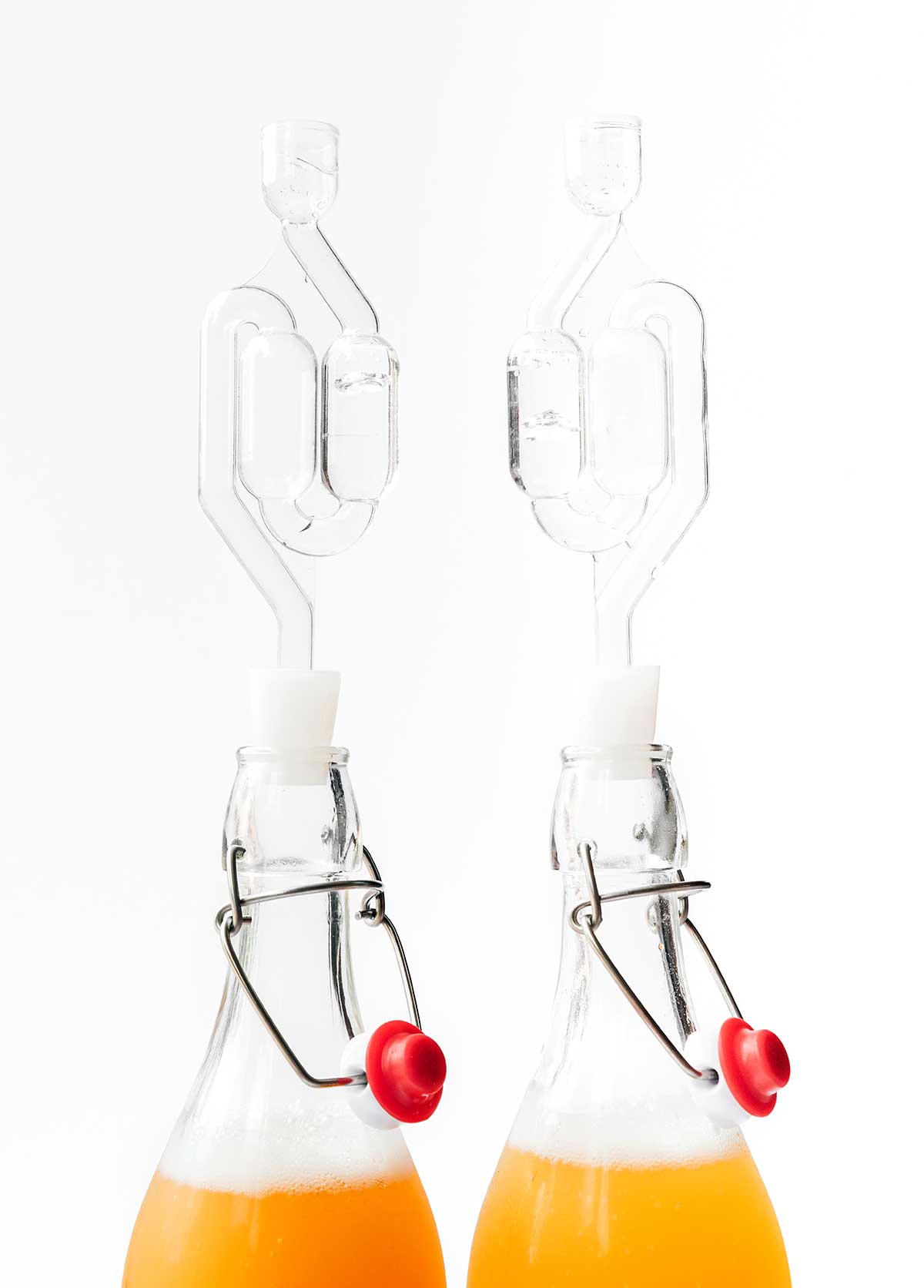
The basics of hard kombucha
Kombucha naturally contains some alcohol (about 0.5%). This is due to the reaction between the naturally occurring yeast in the kombucha, which produces trace amounts of ethanol (alcohol).
Typical kombucha yeast strains do not produce much alcohol on their own, so what do you do if you want to increase the amount of alcohol in your kombucha? Add a different kind of yeast!
By adding a different strain of yeast, such as champagne yeast, to your kombucha, you can make a hard kombucha beverage with a higher ABV (alcohol by volume), around 5%!
After much experimentation (and years of brewing non-alcoholic kombucha to help guide me), I’ve finally landed on the method of brewing hard kombucha that’s both easy and reliable. Let’s brew!
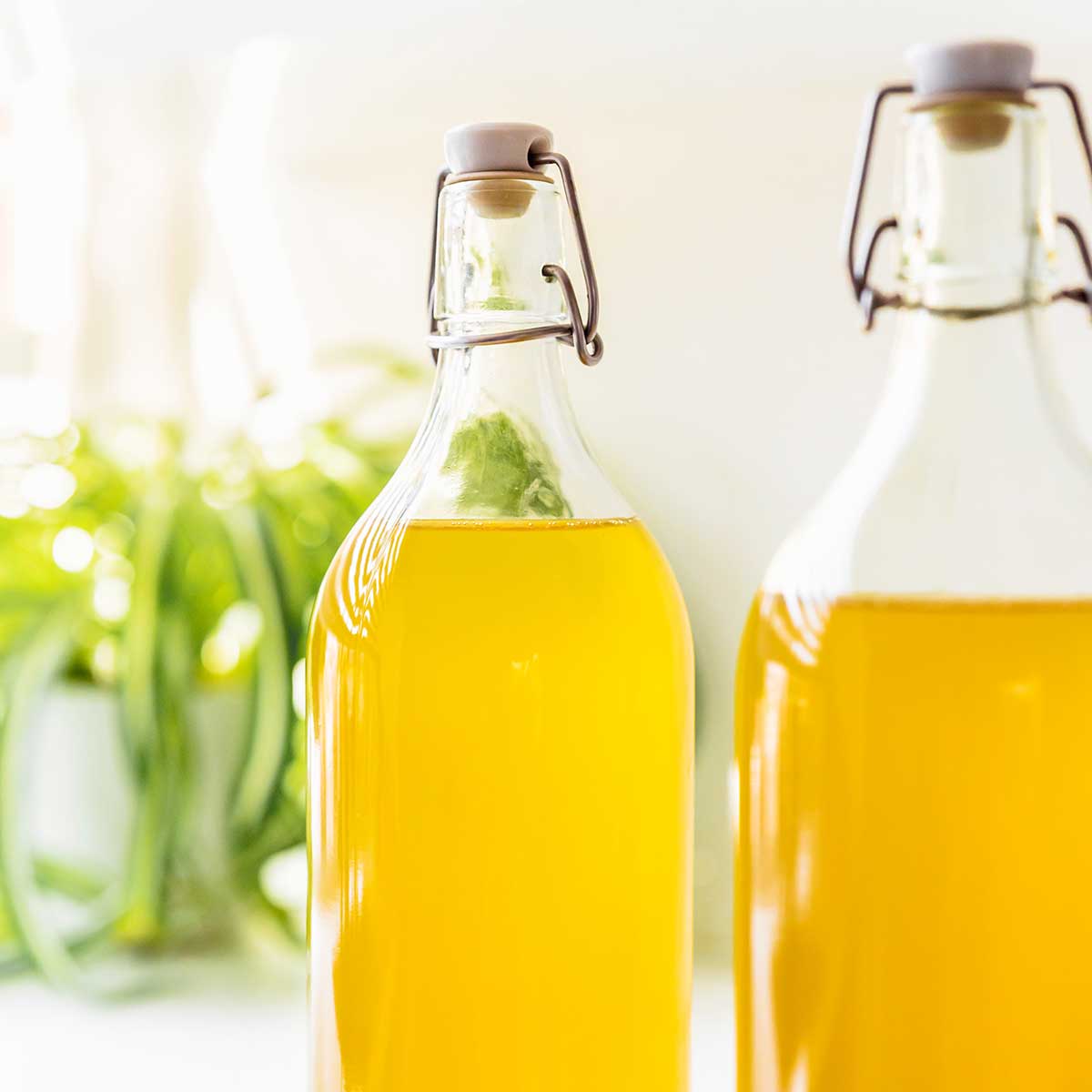
Main Ingredients & Supplies needed for alcoholic kombucha
Kombucha from a first fermentation
First up, you’ll need some kombucha! Take your batch of kombucha straight from the first fermentation to make hard buch. (Here’s how to make kombucha in the first fermentation.) You can use kombucha made from green or black tea here.
Yeast
Adding an additional strain of yeast (different from the kombucha yeast) will help drive up the alcohol content of your kombucha. The type of yeast you choose to use will impact the finished flavor. Some options include:
- Champagne yeast (like this EC-1118 dry wine yeast), which gives a distinctly champagne flavor to your hard kombucha
- Ale yeast (like this SafAle US-05), which has a more neutral flavor
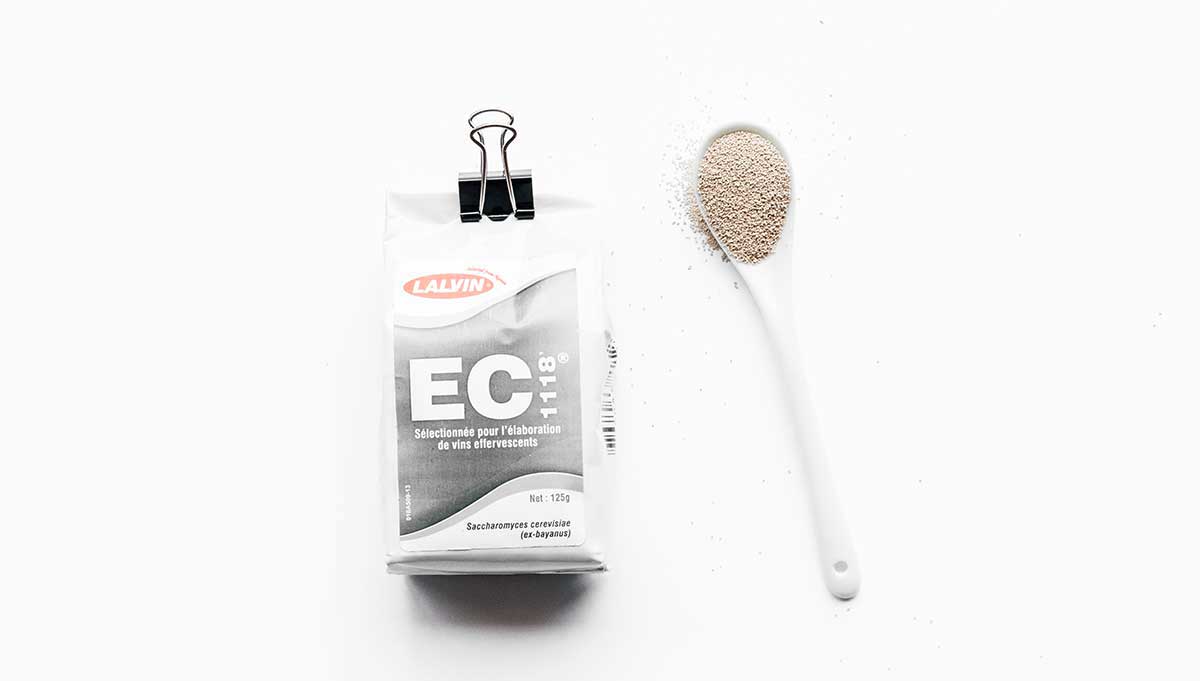
Airlock
The final extra piece of gear you’ll need to brew hard kombucha are airlocks. These effectively let carbonation escape without letting oxygen in.
“But doesn’t kombucha need oxygen?” Good question! When making kombucha in the first fermentation, the bacteria need oxygen to ferment properly. But once the kombucha is finished and you’re ready to booze it up, you’ll want to prevent oxygen from getting to the bacteria so that the bacteria don’t eat the alcohol you’re making! (More on the relationship between bacteria and alcohol in kombucha here.)
A lid won’t work here because you need to allow for air to leave the bottle!
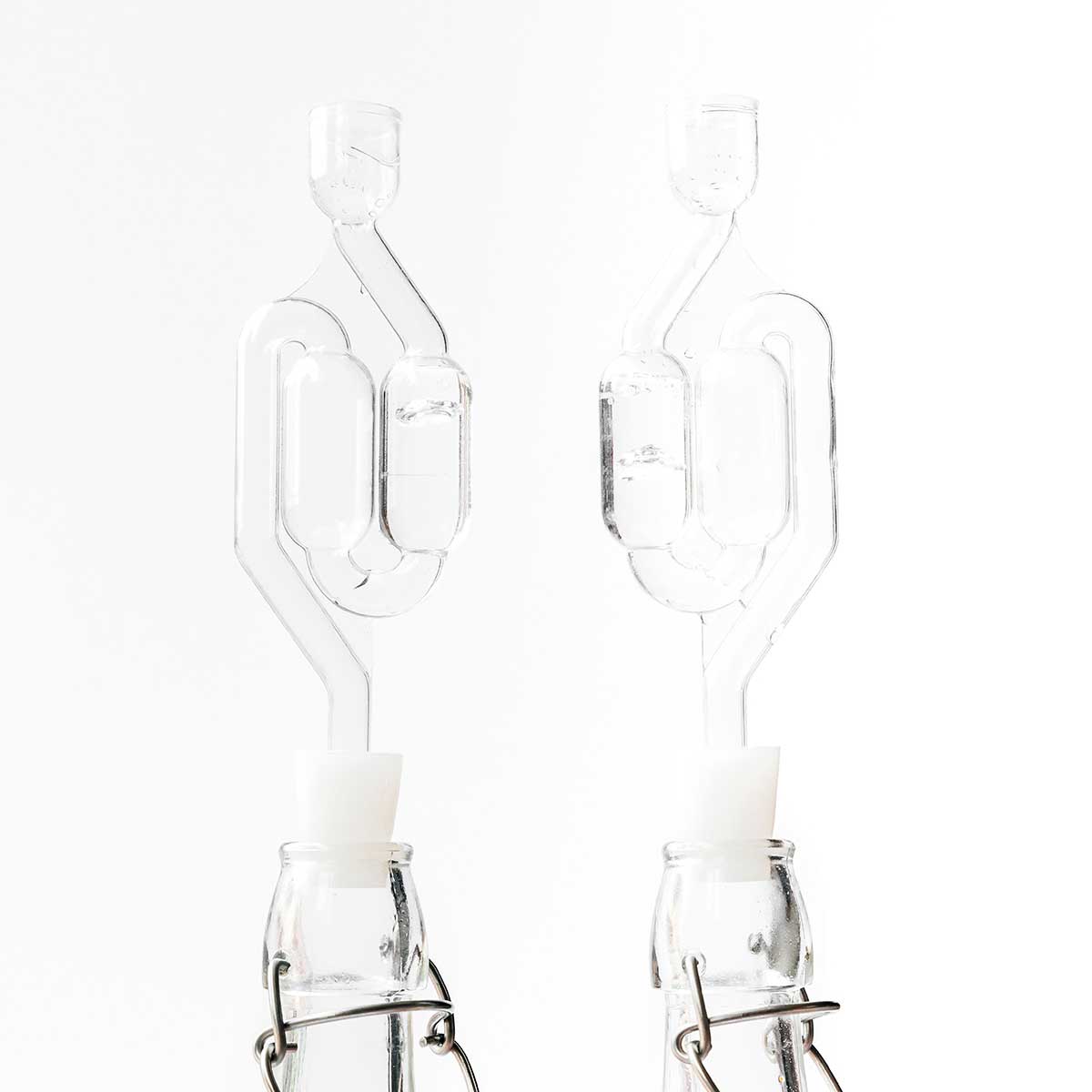
How to make hard kombucha
The process of making hard kombucha is a little different from making traditional kombucha in that we’re adding an extra step in the middle. It goes something like this!
- 1st Fermentation: Make the kombucha (6 to 10 days). This is when you turn sweet tea into kombucha!
- 2nd Fermentation: Make it boozy by adding yeast and sugar, then let alcohol develop (7 to 14 days)
- 3rd Fermentation (optional): Add flavors and seal shut to carbonate (3 to 10 days)
Easy enough, right? Let’s dig into the details!
1st Fermentation: Make the kombucha
In the first step, you’re making kombucha just as usual. You’ll just put sweetened tea, starter kombucha, and a SCOBY (symbiotic culture of bacteria and yeast) into a large jar and let it ferment for 6 to 10 days until you reach your desired flavor (a mix of sweet and tart). Get instructions for the first fermentation here.
2nd Fermentation: Make it Boozy
In the second step, we’ll add a slurry of yeast, sugar, and water, which will increase the alcohol content of your brew. You’ll need:
- 1 cup hot water
- 1 cup white sugar
- 1 tsp yeast (champagne or ale yeast, see notes above)
- 1 gallon of kombucha (from first fermentation)
- Airlocks
1. Yeast Slurry: Stir together the hot water and sugar until sugar is dissolved. Let it cool to lukewarm, then stir in yeast. Allow the yeast to activate for 5 minutes, until bubbles form and the yeast is frothy.
2. Bottle: Meanwhile, transfer kombucha to bottles or a growler (or any vessel with an opening that will fit your airlocks. Portion yeast slurry equally into each bottle of kombucha.
3. Airlock: Fill airlocks with water (to the designated line – you may need to read the instructions for your particular airlocks). Place airlocks onto each bottle.
4. Ferment: Set bottles somewhere dark and room temperature, and let ferment for 7 to 14 days. It’s ready when the flavor is somewhat dry and boozy! If you’re not moving on to the next step (adding flavor), seal the bottles shut and transfer to the fridge to stop the fermentation process.
“I’ve made it and it’s WONDERFUL!
I was wondering what you needed to do to raise the alcohol content. More Yeast? More sugar?”
3rd FERMENTATION: Add flavor
In this final (and optional) step, you can add flavors to give your hard kombucha a fun taste. This is the equivalent of the “second fermentation” in traditional kombucha brewing. You’ll just add whatever flavors you want to your bottle (like pureed fruit, fruit juice, ginger, herbs, or spices), then seal it shut. Let sit for 3 to 10 days, until bubbly and carbonated. Transfer bottles to the fridge to stop the fermentation process. Check out all of our flavor recipes here!
How much alcohol is in my hard kombucha?
The amount of alcohol in your finished hard kombucha will depend on how much sugar you added in the 2nd fermentation. Typically each 1 cup of sugar will give you about 4% ABV. Increasing this ratio and adding more sugar will result in a higher alcohol level.
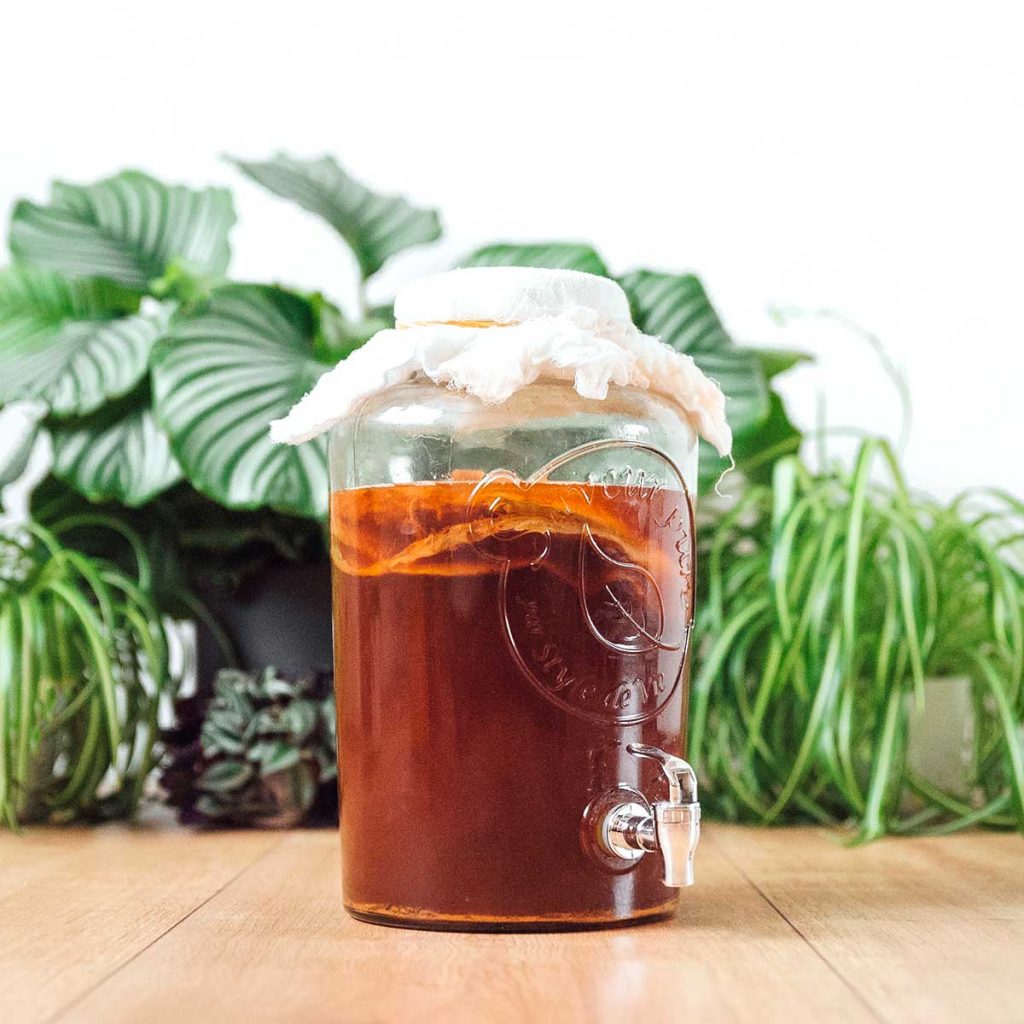
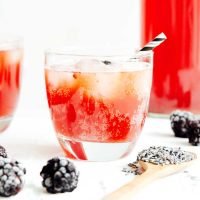
How To Make Hard Kombucha
Ingredients
- 1 cup hot water
- 1 cup white sugar
- 1 tsp champagne or ale yeast
- 1 gallon unflavored kombucha from a first fermentation
Instructions
- Yeast Slurry: Stir together the hot water and sugar until sugar is dissolved. Let it cool to lukewarm, then stir in yeast. Allow the yeast to activate for 5 minutes, until bubbles form and the yeast is frothy.
- Bottle: Meanwhile, transfer kombucha to bottles or a growler (or any vessel with an opening that will fit your airlocks. Portion yeast slurry equally into each bottle of kombucha.
- Airlock: Fill airlocks with water (to the designated line – you may need to read the instructions for your particular airlocks). Place airlocks onto each bottle.
- Ferment: Set bottles somewhere dark and room temperature, and let ferment for 7 to 14 days. It’s ready when the flavor is somewhat dry and boozy! If you’re not moving on to the next step (adding flavor), seal the bottles shut and transfer to the fridge to stop the fermentation process.
- Flavor (optional): At this point you can flavor your bottles however you want! See our favorite kombucha flavors here.
As an Amazon Associate and member of other affiliate programs, I earn from qualifying purchases.
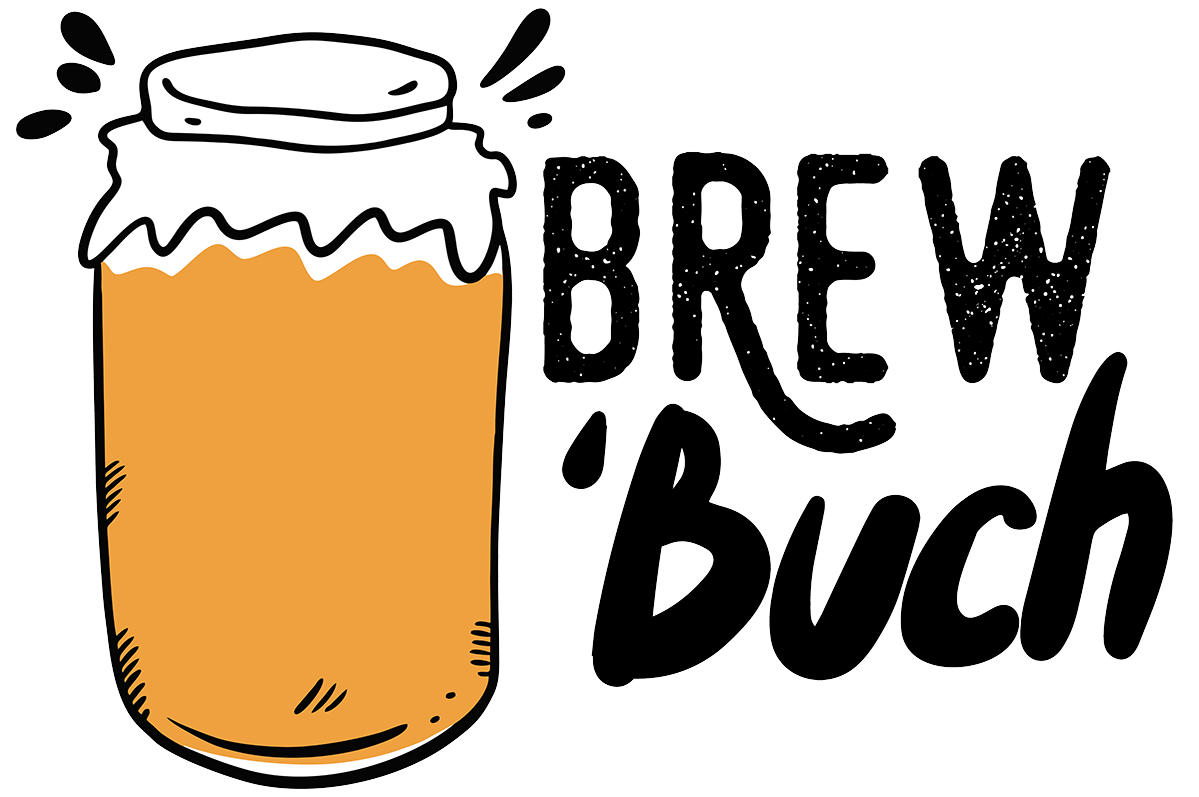
Hi Sarah-
I love your website! I read all the Qs and didn’t see this…my Q is how much air space to leave in bottle neck of F2? Ie between yeasty booch and airlock stopper? Like another person commented, the yeasty foam kinda makes a plug (maybe this goes away in time?) My logic says leave as little air as possible, but I also don’t want the yeast scum and/or a new scoby to plug up the top of the bottle. Am I overthinking this?
I usually fill it up until it’s about at the neck of the bottle! A little air space is good for providing a bit of oxygen to the brew 😀
Thank you for your tips! My first time brewing hard booch – I just finished my 2nd fermentation & started to add fruit for the 3rd ferm. However, while adding the fruit I noticed the booch is already carbonated! Would you have any idea on why that might be? Is this normal? I’m hesitant to seal the bottles for 3rd fermentation, in fear of an explosion haha.
That’s normal – carbonation is a natural part of fermentation!
Help! I accidentally added the slurry to my new batch that did NOT go thru F1! I bottled a batch, started a new one, then added the slurry because I thought i had put the other one up. Ugh! Can I save it??
You could let it ferment and see what happens! In my experience, adding the slurry before F1 creates a much more champagne-like flavor instead of kombucha.
This seems healthy actually.. What are the health benefits? I’m searching for some healthy alcohol consuming. This is red wine seems good.. Read about vodka, but not sure that’s so healthy, this seems better. 😉
But what about all of the sugars in kombucha? That’ not healthy so red wine might be best.. I have not done much scientific medical research.. Have anyone of you?
How much sugars are in these drinks? What’s the pros and cons? Thanks!
I left my SCOBY in for my yeast fermentation. I simply added the yeast/sugar slurry to the gallon jug. Should I remove the SCOBY? Or can I use it for another hard kombucha 2nd fermentation?
I’d remove it so it doesn’t become contaminated with another strain of yeast! But it can be used for further 1st fermentations 😀
Hi just started brewing kombucha and would like to try hard kombucha. I live in kind of a remote part of Alaska and I’m having a hard time finding champagne yeast. I have a batch that’s ready for the second fermentation so I’m kind of desperate to move forward with it. Is there anything else I can use like a can of already made hard kombucha? I see that you said bakers yeast would not work. HELP!
I’m not sure if another can of hard kombucha would work honestly, but it could be a fun experiment! I had best luck finding champagne yeast online if you’re able to get it that way.
Thanks for this great guide Sarah! I’m wondering how much sugar I would have to add to make kombucha closer to wine strength? For instance, do you know how much ABV would increase if I, say, doubled the sugar to 2 cups? Would that cause any issues with the fermentation or flavor? Thanks again!
Each additional cup of sugar should result in a 4% increase in alcohol 🙂
Hi,
I’ve tried making two batches of hard kombucha, and both times it seems as though there is little to no alcohol content. I thought maybe I messed up the ratios the first time but was diligent the second time around, but ended up with the same result. I used ale yeast in the 2nd fermentation. Could it be the yeast, or add more sugar, or possibly my airlock setup?
Thanks!
Typically to get more alcohol you would just need to add more sugar!
Hi Sara, thank you for this!
One question, for the yeast mix can I use organic unrefined cane sugar (azúcar mascabo)? cause its hard for me to see the bubbles after putting the yeast and I don’t want to waste more of it.
thank you!
I would only recommend using these sugars for kombucha brewing!
Love your style.
Knowledgeable but not a know it all.
I’m anxious to try the hard stuff.
Last time I tried I ended up with vinegar and quit brewing altogether.
My 2nd batch of hard kombucha tastes really yeasty. What did I do wrong, the first batch was delicious, I used your raspberry zinger recipe.
It could have just over fermented a bit? Try letting it ferment for a little less time next batch!
I started two jars of kombucha (w/ champagne yeast slurry) 20 days ago and only one of them is cloudy and bubbly. The other one looks like regular kombucha. I dumped half the contents of the slurry into one jar and the rest in the other. Could it be that most of the yeast ended up in only one jar, so the 2nd jar will not have much extra alcohol?
That’s definitely possible! If one has more champagne yeast it’s going to have more activity / alcohol.
Hi! Thanks for the info. I am a baker so am familiar with that yeast process. I am having trouble getting my champagne yeast to foam, but perhaps I am just thinking about what baking yeast would look like and my expectations for proofing are too high? I am now on my fourth try. Whatever happens this time is going in and we’ll just see. LOL I am at a low altitude. I let the sugar mixture cool to around 98 F. Any thoughts on this would be appreciated! Thank you!
It won’t look quite like bakers yeast – just look for SOME activity 😀
Your info is fabulous. Thanks……I made my first Champaign Batch…..Did all 3 Fermentation s. I did not taste or feel any Alcohol in the end product. It actually was rather thick in texture. I did the yeast in the slurry but it did not activate. It remained like little beads and never seemed to dissolve. I used the product you suggested. Could it be Old? It came from Canada could this be why there was not any alcohol in it? Or some other reason.
Your response is appreciated. On my second batch I will try to leave the 2F longer………
It could have been old or dead somehow! You’ll want to make sure that yeast slurry is alive and bubbling before using it next time 😀
After several years, I am ready to try making hard kombucha. One question. On the second fermentation process when I add the champagne yeast do I leave the Scoby out or leave it in?
Leave the SCOBY out of this step 😀
Hi Sara: (1) Thanks for having such a helpful website with easy to follow instructions!
(2) I am trying to make kombucha and also hard kombucha with as little sugar present at the end. I am getting super mixed info on the Internet about whether a refractometer will work to accurately measure the sugar content of either the non alc or alcoholic kombucha. Where do you land on this debate? And if the refractometer doesn’t work, how else could one measure the sugar content?
Thanks!
I land on the side of…it probably won’t be very accurate. I would just use your tastebuds instead! When it’s pretty tart, most of the sugar should be out (you can use store bought bottles for a taste reference – their nutrition info will be correct because they send it off to labs for sugar analysis).
I want to make kombucha with minimum alcohol, as I want to start making it commercially but as I am starting I will be fermenting in rented commercial kitchen. Can you help me with the process which makes sure it produces minimal alcohol.
thank
Here’s our article about the naturally occurring alcohol in kombucha. Really the only way to get less alcohol is to let it ferment for less time!
very nice
Ok, thank you! Does the ginger make it more susceptible to mold?? If the first batch goes ok, is she in the clear regarding starting with gingerade? Seeing your response, she’s concerned that all subsequent batches may be MORE susceptible to mold because she started with that…is that true? Thanks for the help!
I would think if it survives the first batch made with gingerade, all subsequent batches will get less and less apt to mold (as you ferment the ginger out).
Ok. Thanks! Quick question….just gave my sis some scobies and taught hear how to get started. She couldn’t find any original GT’s ANYWHERE, and ended up using the GT’s Gingerade for the starter (I couldn’t fly with several cups of my starter). Will it work….or will the ginger inhibit it???
Thanks for the help!
It may work, just tell her to keep a good eye out for mold!
Sarah…
When I make the slurry and put it in the bottles, it rises to the top to make a “pl;lug”. Is that normal? I’ve tried to get it to mix in….but eventually rises to the top again, and 2 weeks later, my kombucha is still super sweet (used 1 cup sugar and only had 6 airlocks) and not boozy. Any hints? Seems like it’d be easier to make a gallon in one large jug rather than in separate bottles.
Thanks for the tips!
You could try gently flipping it over everyday to keep it from rising like that! 😀
Thanks Sarah – appreciate your advice.
Hi Sarah
When making hard kombucha, should you stir the vessel at the end of the 3rd fermentation (which has wine yeast in it) before bottling (in the same way you would do at the end of the 2nd fermentation)?
Yes that would be best! 😀
Oh my gosh, I didn’t even know this was a thing! I just started my next round of continuous brew today, and am going to order some supplies to try this.
I always do my second fermentation in flip-top 750mL bottles. Depending on what I have in there, I burp 1-2x/day. If I were to flavor on the 3rs ferment of hard kombucha, would I still follow my same burping routine?
Also, how many 750mL bottles would that 1c sugar/1tsp yeast ratio cover? Could I double it if I wanted to raise the ABV? So excited!
I would still burp them! And should cover about 6 bottles if my math is right. Increasing the sugar would increase the finished alcohol level 😀
Hi Sarah
I’ve only just found your website and love the look of all your recipes. I’ve been brewing non-alcoholic kombucha for about 6 months and I’m about to progress to hard kombucha. I have usually brewed enough non-alcoholic for normal daily consumption. If I step up production how long will I be able to keep hard kombucha after the 3rd fermentation? Can it mature in bottles like wine or champagne? Would I need to keep it in the fridge? Many thanks.
I don’t think it would mature quite the same as wine, and I would keep it in the fridge to stop the fermentation (and thus stop bottles from exploding).
Hey there!
Thank for sharing your experience.
I have a question.
If I add more sugar and water in the 3rd fermentation the alcohol level will be the same?
More sugar will likely increase the alcohol content a bit!
Hello! I’ve tried making this twice now, but both times after two weeks the kombucha has still been extremely sugary sweet. It’s not drinkable.
I’m thinking there is something going wrong during the activation of the yeast.
I’m trying to save my second attempt, so as to not waste further precious kombucha, by reactivating 1 tsp ale yeast in 1 cup water between 90-100 degrees without the sugar; I will then just try pouring the yeast and water slurry into the overly sweet, and definitely not hard, kombucha. I have no idea if this will work but giving it a try.
Any words of widsom?
Perhaps try a different yeast? And otherwise, make sure your kombucha is pretty tart before adding the yeast slurry (aka before the second ferm).
I am so excited to try this. We are doing homemade Christmas gifts this year! A couple of quick questions:
Will it be a little carbonated?
I love grapefruit, do you have any recipes for adding fresh grapefruit juice?
Thank you,
Brandi
Yep, if you do a third fermentation where you seal off the bottles it should carbonate. And here’s how we add grapefruit.
To what consistency do I stir in the yeast? Should it dissolve like the sugar or should I gently stir it throughout the batch of kombucha. Thanks.
Just dissolve it like you do the sugar! 😀
Hey Sarah, great instructions, really appreciate all the info! One question, do you take any gravity measurements or anything to confirm the second fermentation is finished? Always cautious about accidentally creating bottle bombs if there’s still too much sugar left when doing the final bottling. Also does any additional sugar need to be added in the third step to carbonate, or should there be enough left to allow the kombucha to be carbonated?
I actually haven’t tried taking gravity measurements before! I’ll have to look into it. And yes, I do add a little fruit (or sugar/honey) in the final ferm to ensure it gets nice and carbonated.
I’ve never used air locks. When I take them off will the kombucha spray everywhere? In the summer due to heat the carbonation in my second (fruit) ferment has been known to blow to the ceiling. (-;
An airlock would actually prevent this! It allows air to go out without allowing any in 😀
My second ferment of 1 gallon kombucha, 1.5 t. Champagne yeast, 1c. sugar in 1c. water, 10 days, grew its own new SCOBY. Lid on instead of cloth. A bad thing or not?
Natural part of the fermentation! 😀
Thanks, I just started my first batch but after re-reading this I realized I put the whole packet of yeast in. Will this be ok? I used EC1118 yeast. I planned on adding fruit after F2 was done before bottling into growlers.
It depends on how big the bag of yeast was! You can always add more of the other ingredients to hit the right ratio. Otherwise it may just have a more yeasty flavor.
Can i use regular bakers yeast?
Not in this case – it’s a different strain of yeast than champagne yeast.
Good afternoon,
My hard Kombucha brew has turn cloudy, should I be concerned? It’s on it’s fourth day fermentation.
Thank you
Virginia
Cloudy means there is a lot of yeast activity, which is good!
Thank you for the info . Will this beer still have the good healthy characteristics of the kombucha ? Or the yeast and sugar overpower this?
Yep it sure will have those healthy properties! 😀
Sara,
What is the process to make the water-sugar & yeast-nutrient mixture?
The following is the process I have just used. I would appreciate feedback to figure out where things need an update. Thank you.
I’m seeking comments, guidance or feedback on my current process.
A 10 day F1 was finished last Tuesday and starting a F2 on Tuesday evening. This is my 4th attempt at making a successful F2. Attempts 1-3 were solid failures!
I have read numerous articles from this group and other sources (BoochCraft etc), watched YouTube video clips and I seem to be missing some nuance of success. Bottom line is I’m frustrated with the nominal processes posted so I would appreciate some guidance. I’m suspect of how much sugar to add and how much EC-1118 to add. In the past I may have not added enough sugar and EC-1118 yeast. The following is my current process.
Two 1 gallon growlers fermenting F2. ‘A’ & ‘B’.
Growler ‘A’ has 450g of cane sugar (target is 5%). 1 package of EC 1118 champagne yeast. 5g DAP, 1.5g FermaidO, and the balance of F1 Kombucha. Boiled water, cooled to 37C, added 1 cup water (previously boiled), 50g sugar, 5g DAP, 1.5g FermaidO. Stirred and placed in 1 gallon growler that has 2.5 liters of F1 at room temperature and 400g sugar (450-50).
Growler ‘B’ has the same except for 535g sugar for a target alcohol of 6%. Same process with 1 package of EC 1118 yeast and nutrient additions.
Process as follows.
a) Boiled 1+ cups of water for sugar-yeast slurry for two 1-gallon growlers.
b) Dissolved 100 grams of cane sugar into 1+ cups of previously boiled water. Temperature 40-42C.
c) Moved 1/2-cup water-sugar mixture to sanitized glass bowl, cooled to 37-38C and added DAP and FermaidO, stirred. Added 1 package if EC 1118 champagne yeast to each 1-gallon growler. Let sit for 10-15 minutes while maintaining temperature using a water bath.
d) To each 1-gallon growler, I dissolved balance of cane sugar in approx. 2.5 liters of F1 Kombucha. ‘A” has 400g and ‘B’ has 485g cane sugar.
e) To each 1-gallon growler I added approx 1/2+ cup of water, dissolved cane sugar, DAP and FermaidO and EC-1118.
f) Each gallon growler is filled to the base of the neck. (Note: nominal residual pedicle flowed into each growler and subsequently floated to clog the growler neck or seep into the airlock.)
g) Inserted airlocks using vodka as the liquid.
h) Day 3, good bubbles. I may have over filled both so I poured off a bit to clear the growler necks, cleaned the airlocks, refilled with vodka and all looks good. Bubbles are frequent.
i) F2 ferment should have a duration of (how many days – range)? a) until there are no more bubbles, b) until the bubbles flow at a much slower rate, c) taste test?
j) Temperature is 75C.
k) Original SG nor Final SG were not measured.
Thank you for your assistance.
Hi Robert! What have the “failures” entailed? The flavor being off? You might post this in our Facebook group – they’re GREAT at helping to troubleshoot more complex problems like this one!
Hi Sarah, Thank you for all the wonderful information you share with us.
Can you use the Scobys from the second ferment (boozy) as a starter Scoby and would it be ok to add it to the Scoby hotel ??? Just hate to waste.
I wouldn’t recommend adding any non-traditional (i.e. flavored or boozy) SCOBYs in with the others. Use them in other ways (like in smoothies or to make candy!)
Thank you for the great recipes
Do you have any tips on making a higher alcohol content than that? Im using Safale US-05 ale yeast. Im new to brewing hard kombucha, but have made it for the first time recently and want to up the alcohol to the limits of the yeast. I assume it needs more sugar, but I don’t know how much. Do you have any suggestions?
Yep, generally more time and more sugar = more alcohol. Typically each 1 cup of sugar will give you about 4% ABV.
What if you leave the kombucha to sit for longer? Will it get more or less alcoholic?
It will become more alcoholic the longer is ferments.
I also brew beer and have 5 gallon carboys that are fitted with air locks for beer wort fermentation. Do you think pouring all my first fermentation tea into one big vat ( I continuously brew about 5 gallons of kombucha in 4 containers) will still work?
I haven’t tried this so I can’t say for sure, but I think it would work! Would love to hear how it goes.
Shouldn’t we strain the second ferment through strainers or filters to remove the spent yeast/particulate? Is there a reason you wouldnt?
You can, but it’s not necessary! It’s more of an appearance thing than any.
I just finished brewing plum wine that is from 4-5 years ago. Now I have some plums from the plum wine left. I’m thinking if this is a good source of “yeast and sugar” for the second fermentation. What you think?
Oh so cool! I honestly have no idea if you could use those, but I’d say it’s worth trying out!
Hello
I noticed growth in my second ferm . I’m used a growler , and added my wine yeast . But on day 2 I noticed growth – almost Scoby like. Is this normal ?
Yep, that’s normal! SCOBYs are a natural biproduct of the fermentation.
Hi ,
Do you have tips , tricks on what a good Scoby looks like ? Color, thickness ?
Approximately 1/4” and thicker, from what I understand. Colors seem to vary quite a bit, tho mine have been tan-yellowish with other color variations. Research “kombucha/ SCOBY mold” galleries online. I’m new at it, so still trying to differentiate between mold and a healthy SCOBY! Not easy at first. Lots of variations of healthy SCOBY’s out there.
Hi Sarah, thanks so much for this great information! For the second fermentation stage, can I use smaller ratios of water, sugar, and yeast if I am making a smaller batch of kombucha (e.g. 1 litre as opposed to 1 gallon)? Thanks!
Yep! Just keep the ratios the same 😀
Great instructions. I’m trying to take short cuts , and make a hard Kvass recipe using many components of your recipe . I plan to use bread as my “scoby” .
What are your thoughts ?
I’ve never tried making Kvass so I really can’t say for sure. Looks like there are w few good guides online about it though! You may want to follow a guide specific to Kvass though, because I think kombucha is pretty different.
Just leave the kvass to ferment alone..dont need the scoby…after2 weeks itll knock your socks off. Burp daily and only full the bottle 3/4. If youre using glass bottles for f2 only use beer bottles and have a plastic one about the same size as a pressure tester (if u dont burp daily) if plastic bottle hard you know your kvass will be super/dangerously fizzy. I do f2 in plastic soda bottles 3/4 full and burp daily. Unless you and your room want to wear it whenever you open it..burp daily.brcame alcoholic in 2 weeks in fridge. Ive ordered a hydrometer from aliexpress so i can check alcohol content to be sure but its pretty strong. Hth
If you shred the beets, you WILL make alcohol…fyi????
Thank you!!
Thank you so much for sharing all this information! I usually use pureed fruit for my regular kombucha and add it to the gallon jug for the second fermentation. For hard kombucha, if I use the gallon jug (with an airlock) for the second fermentation but transfer the liquid into airtight bottles for the 3rd fermentation, how much pureed fruit would you use in each individual bottle (11oz bottles)? Thank you!
Probably about 1 or 2 Tbsp of puree! 😀
Thank you for this! I just let my kombucha ferment for 11 days and it has a nice, dry flavor! I did have a small SCOBY start to grow in my hard brew. Is this normal? Thanks!
Yep that’s normal, just a natural product of fermentation! 😀